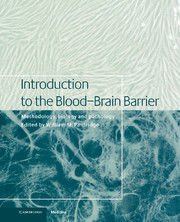Book contents
- Frontmatter
- Contents
- List of contributors
- 1 Blood–brain barrier methodology and biology
- Part I Methodology
- Part II Transport biology
- 18 Biology of the blood–brain glucose transporter
- 19 Glucose transporters in mammalian brain development
- 20 Blood–brain barrier amino acid transport
- 21 P-glycoprotein, a guardian of the brain
- 22 Blood–brain barrier ion transport
- 23 Ion channels in endothelial cells
- 24 Interactions of lipoproteins with the blood–brain barrier
- 25 Fatty acid and lipid intermediate transport
- 26 Blood–brain barrier transport of drugs
- Part III General aspects of CNS transport
- Part IV Signal transduction/biochemical aspects
- Part V Pathophysiology in disease states
- Index
23 - Ion channels in endothelial cells
from Part II - Transport biology
Published online by Cambridge University Press: 10 December 2009
- Frontmatter
- Contents
- List of contributors
- 1 Blood–brain barrier methodology and biology
- Part I Methodology
- Part II Transport biology
- 18 Biology of the blood–brain glucose transporter
- 19 Glucose transporters in mammalian brain development
- 20 Blood–brain barrier amino acid transport
- 21 P-glycoprotein, a guardian of the brain
- 22 Blood–brain barrier ion transport
- 23 Ion channels in endothelial cells
- 24 Interactions of lipoproteins with the blood–brain barrier
- 25 Fatty acid and lipid intermediate transport
- 26 Blood–brain barrier transport of drugs
- Part III General aspects of CNS transport
- Part IV Signal transduction/biochemical aspects
- Part V Pathophysiology in disease states
- Index
Summary
Introduction
Voltage gated channels are essential for determining membrane excitability, for instance in neurons. A large body of evidence indicates that voltage gated channels are not the only forms of channels expressed by mammalian cells and that expression of ion channels is not restricted to excitable cells. Voltage independent channels do not open in response to a change in the membrane potential. They open (or close) in response to phosphorylation, to intracellular ligands (ATP, H+, etc.) and signalling molecules (Ca2+, G proteins, etc.), to extracellular ligands (acetylcholine, serotonine, ATP, GABA, excitatory amino acids) and to physical stimuli (shear stress, osmolarity, etc.). Increasing evidence also suggests that vascular endothelial cells from peripheral vessels express ion channels and that these channels play an important role for modulating endothelial cell functions (Adams, 1994; Takeda and Klepper, 1990). This chapter reviews the properties, regulations and possible functions of ion channels expressed by brain capillary endothelial cells (BCEC).
Expression of ion channels is best analyzed using patch clamp techniques. Channels are characterized by their voltage dependence, ionic selectivity, unit conductance and in some favorable cases by unique pharmacological properties. Ion channel activity can sometimes be analyzed by ion flux techniques (e.g. Van Renterghem et al., 1995) or by ligand binding techniques (e.g. Vigne et al., 1989). Molecular data are available for many voltage gated channels (Catterall, 1995).
- Type
- Chapter
- Information
- Introduction to the Blood-Brain BarrierMethodology, Biology and Pathology, pp. 214 - 220Publisher: Cambridge University PressPrint publication year: 1998
- 3
- Cited by



